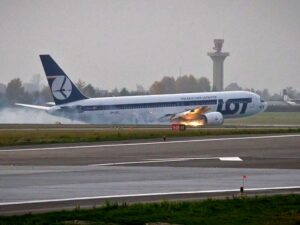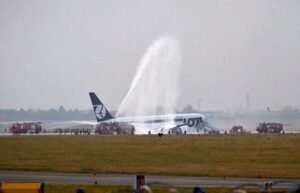A resurfaced video of a miraculous emergency landing in 2011 sparks comparisons to South Korea’s recent tragic crash.
Terrifying footage has resurfaced showing a plane landing on its belly without wheels, drawing renewed attention in light of the recent South Korea plane crash that claimed 179 lives.
The video, originally aired in 2011, captured the heart-stopping moment a Boeing 767, carrying 231 passengers, landed without its landing gear at Warsaw Chopin Airport in Poland. Unlike the recent tragedy in South Korea, this earlier incident ended miraculously—with no injuries reported.
The Polish Miracle Landing
The Polish LOT Airlines flight had traveled from Newark, New Jersey, to Warsaw when the pilots discovered a critical problem with the landing gear. For over an hour, they circled the airport, attempting to resolve the issue while preparing for an emergency landing.

As the plane approached the runway, millions watched live, holding their breath. The Boeing 767 eventually landed on its belly, creating sparks and smoke as it skidded across the tarmac. A small fire broke out, but thanks to the crew’s calm and calculated approach, all 231 passengers walked away unharmed.
The footage, widely shared online at the time, is now being revisited in the wake of the catastrophic crash landing of a Jeju Air flight in South Korea on December 29, 2024.
South Korea’s Devastating Crash
Tragically, the Jeju Air incident ended far differently. Out of 181 people on board, only two survived, making it the deadliest aviation disaster in South Korea’s history.

Video footage of the crash showed the plane attempting an emergency landing at Muan International Airport. After failing on its first attempt, the aircraft made a second approach, hitting the runway at high speeds before smashing into a concrete barrier and exploding into a massive fireball.
Why Was the Outcome So Different?
Aviation experts and viewers alike have pointed out stark differences between the two landings. Julian Bray, an aviation specialist, told The Sun that pilots regularly rehearse emergency landings like these in simulators and that most aircraft have manual systems to deploy landing gear if hydraulics fail.
However, Bray highlighted key factors that worked in favor of the Polish flight. The pilot had time to dump excess fuel, reducing the plane’s weight and speed to a manageable 120 miles per hour. Additionally, the aircraft had two functioning engines, allowing for greater control during the descent.

In contrast, Bray suspects the Jeju Air flight may have been grappling with sudden engine failure or other severe mechanical issues, possibly caused by a reported bird strike. “You don’t know whether you’re running on reserve electrics because the generator’s not working—that powers the hydraulic pumps, landing gear, and other crucial systems,” he explained.
The Role of the Runway’s Design
The investigation into the South Korean crash is ongoing, but Bray also drew attention to the role of the runway’s design.
Reports suggest the jet collided with a concrete barrier at the end of the 2,800-meter runway. While often described as a “wall,” Bray clarified it was likely a slab designed to collapse on impact, absorbing some of the crash’s energy.
“If that slab hadn’t been there, there’s a good chance more people could have survived,” Bray speculated.
A Sobering Reminder
The 2011 footage is a powerful example of how training and quick thinking can make a critical difference in emergencies. While the Polish landing showcased the calm and skill of experienced pilots under extreme pressure, the South Korean crash is a tragic reminder of how unpredictable and unforgiving aviation incidents can be.
As investigations into the Jeju Air crash move forward, experts are working to identify what went wrong and what can be learned to improve safety measures and prevent future tragedies.

